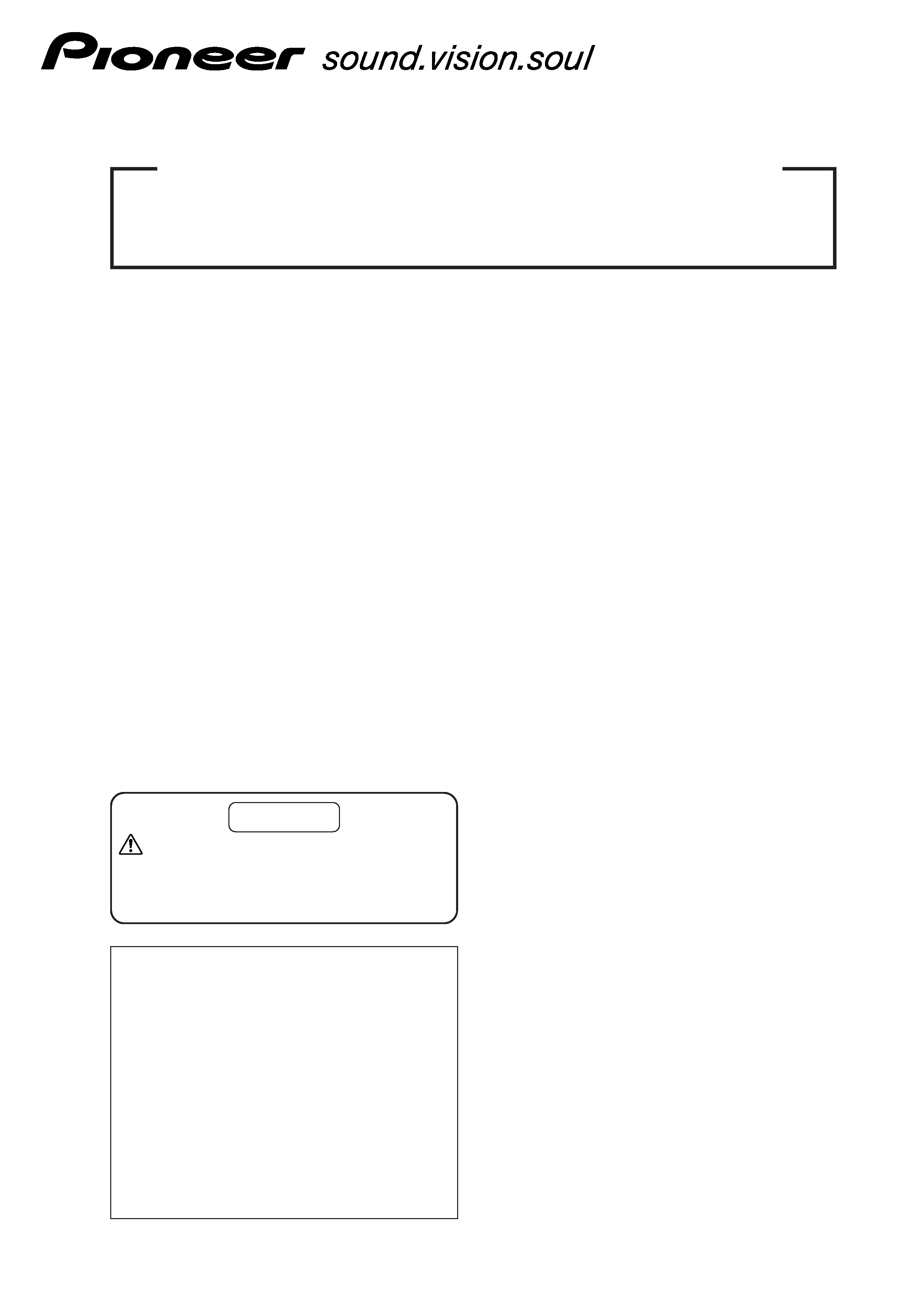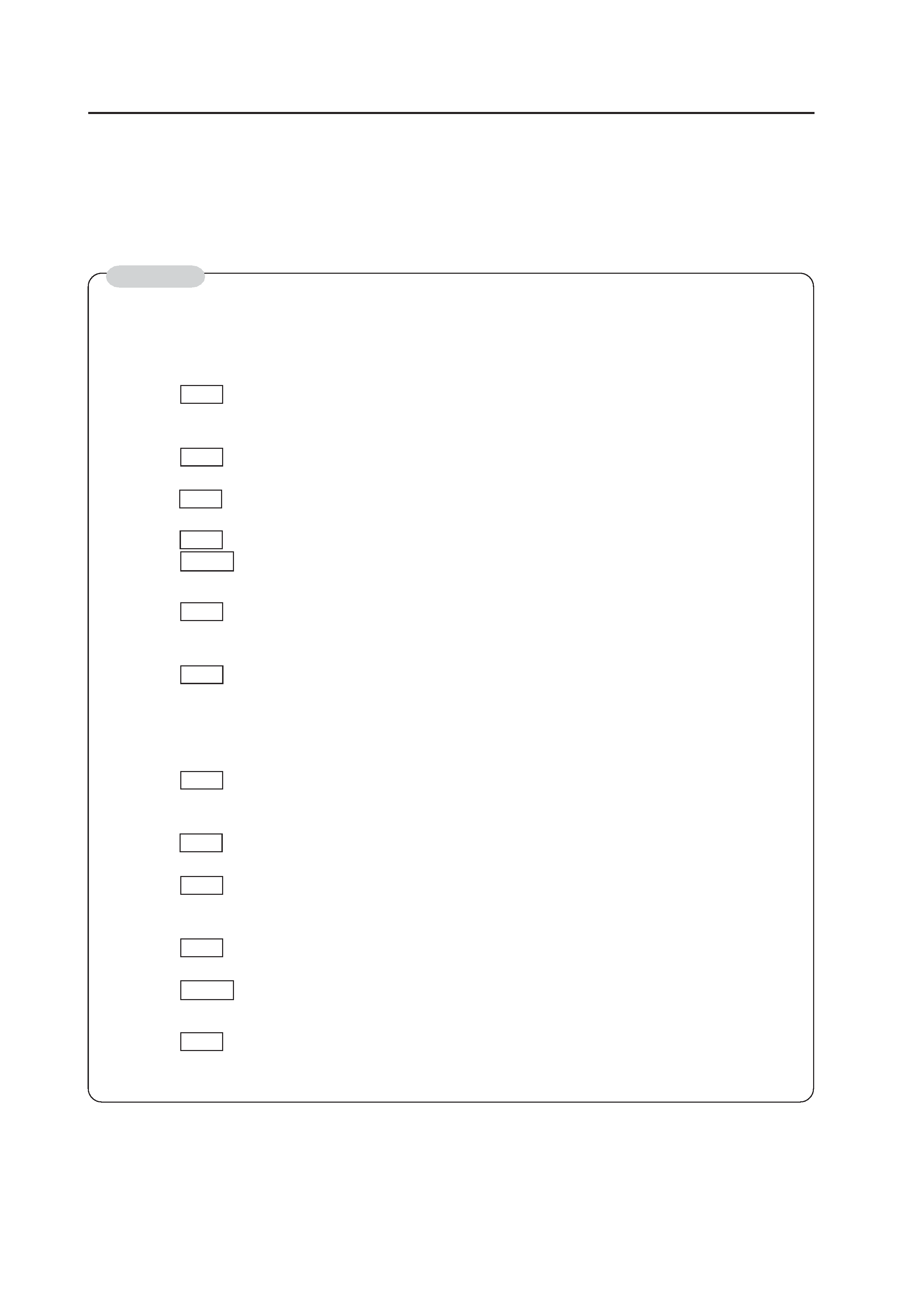
PLASMA DISPLAY MONITOR: PDP-425CMX/PDP-42MXE10
VIDEO CARD: PDA-5003/PDA-5004
TABLE TOP STAND: PDK-TS01
TILT MOUNT UNIT: PDK-5011
WALL MOUNT UNIT: PDK-WM01
CEILING MOUNT UNIT: PDK-5012
MOBILE CART: PDK-5014
SPEAKER SYSTEM: PDP-S44-LR
ABOUT MOUNTING/INSTALLATION
÷ This product is sold under the assumption that
installation will be performed by experienced,
qualified experts. Refer all mounting and
installation work to qualified personnel, or consult
the nearest PIONEER dealer for assistance.
÷ We accept no responsibility for accident or loss
resulting from failure to select an appropriate
installation site, or for those occurring during
assembly, installation, mounting, or operation of
this product, or resulting from modifications made
to this product, or from natural disasters.
PRECAUTIONS:
· We accept no responsibility for losses resulting from
the use of parts other than those supplied by us.
· We guarantee the performance of our products only
when they are assembled and adjusted as described in
this manual.
· The specifications and external designs shown in this
manual are subject to change without notice.
CAUTION
Exclamation marks placed within triangles are
intended to alert users to the presence of important
safety information. Be sure to read instructions
indicated by this symbol.
This manual provides precautions and information for installation, preparation, and handling of the Plasma Display and
its dedicated mounting hardware.
Before installation and preparatory work, choose a safe and appropriate site after thorough consideration of construction,
materials used, strength, and surroundings. If adequate safeguards are not in place, immediately halt the installation
process and discontinue marketing activities.
TECHNICAL MANUAL (Ver. 1.0)
FOR PIONEER PLASMA DISPLAY MONITOR WHEN USED WITH
VIDEO CARDS (EXPANSION SOLUTIONS CARDS)

2
Table of Contents
INTRODUCTION ..................................................................... 4
FEATURES .............................................................................. 5
SPECIFICATIONS
2.1 Specifications ............................................................... 6
2.2 External Dimensions .................................................... 8
2.3 Controls and Connectors ........................................... 10
2.4 Pin layout .................................................................... 13
2.5 Remote Control Unit .................................................. 14
2.6 Remote Control Unit Holder ..................................... 15
INSTALLATION SITE REQUIREMENTS
3.1 Installation Site Requirements .................................. 16
3.2 Installation Conditions ............................................... 18
3.2.1 Heat dissipation ................................................ 18
3.2.2 Calculating heat quantity ................................... 19
3.2.3 Product mounting holes .................................... 19
3.2.4 Mounting surface warping ................................ 21
3.3 Installation Procedures .............................................. 22
3.3.1 Transportation precautions ............................... 22
3.3.2 Unpacking ......................................................... 22
3.3.3 Mounting on the attachment stands ................. 23
3.3.4 Re-packing ........................................................ 24
3.3.5 Wiring ................................................................ 24
3.4 Special Installation ..................................................... 26
3.4.1 Mounting to fittings .......................................... 26
3.4.2 Hanging on the wall .......................................... 28
3.4.3 Embedding in the wall ...................................... 30
3.4.4 When the display is put in a box ....................... 33
3.4.5 Ceiling suspension (with wires) ........................ 34
3.4.6 Hanging on the wall lengthwise ........................ 36
3.4.7 Place product upright and flush into wall
(embedding in the wall) ..................................... 38
3.4.8 Installed facing upward ..................................... 42
3.4.9 Horizontal connections ...................................... 44
3.4.10 Multiple ............................................................. 45
HOW TO USE THE STANDARD MOUNTING COMPONENTS
4.1 Standard Mounting Components Features and
Characteristics ............................................................ 46
4.2 Handling the Standard Mounting Components ...... 47
4.2.1 Handling precautions ........................................ 47
4.2.2 Precautions for installation contractors ............. 47
4.3 Installation of the Attachment Stand ....................... 48
4.4 Video Card: PDA-5003/PDA-5004 .............................. 50
4.4.1 Specifications .................................................... 50
4.4.2 External Dimensions ......................................... 52
4.4.3 Installing procedures ......................................... 54
4.5 Table Top Stand: PDK-TS01 ...................................... 58
4.5.1 Specifications .................................................... 58
4.5.2 Installation coordinates for screws used to
stabilize the stand to the floor ........................... 59
4.5.3 External Dimensions ......................................... 59
4.5.4 Stand assembling .............................................. 60
4.5.5 Attaching the Stand to the Plasma Display ....... 60
4.6 Tilt Mount Unit: PDK-5011 ......................................... 64
4.6.1 Specifications .................................................... 64
4.6.2 External Dimensions ......................................... 65
4.6.3 Assembling the mounting hardware and
mounting the Plasma Display ........................... 66
4.6.4 Angle setup ....................................................... 68
4.6.5 Measure to prevent shakiness when the unit is
installed at a slight tilt ....................................... 69
4.7 Wall Mount Unit: PDK-WM01 .................................... 70
4.7.1 Specifications .................................................... 70
4.7.2 External Dimensions ......................................... 71
4.7.3 Assembling the mounting hardware and
mounting the display ......................................... 72
4.7.4 When removing the Plasma Display ................. 74
4.8 Ceiling Mount Unit: PDK-5012 .................................. 76
4.8.1 Specifications .................................................... 76
4.8.2 External Dimensions ......................................... 77
4.8.3 Installing the mounting hardware ..................... 78
4.8.4 Attach the Plasma Display ................................ 79
4.8.5 Angle setup ....................................................... 80
4.9 Mobile Cart: PDK-5014 ............................................... 82
4.9.1 Specifications .................................................... 82
4.9.2 External Dimensions ......................................... 83
4.9.3 Disassembling the display stand ....................... 84
4.9.4 How to install .................................................... 84
4.10 Speaker System: PDP-S44-LR ................................. 88
4.10.1 Specifications .................................................... 88
4.10.2 External Dimensions (when mounted to the
Plasma Display) ................................................. 89
4.10.3 Installation on the Plasma Display .................... 90
BEFORE BEGINNING ADJUSTMENT/SETTING
5.1 Before Beginning Adjustment .................................. 92
5.1.1 Operation Mode ................................................ 92
5.1.2 Combined Use of the Remote Control,
Main-control Panel, and RS-232C commands ... 93
5.1.3 List of Input Correspondence Signals ............... 94
5.1.4 List of Adjustable and Settable Items ............. 103
5.1.5 Last Memory ................................................... 111
5.1.6 Aging ............................................................... 111
5.2 Normal Operation Mode ......................................... 112
5.2.1 About normal operation mode ........................ 112
5.3 Menu Mode .............................................................. 114
5.3.1 About menu mode .......................................... 114
5.3.2 Concerning the display of the OSD
of each item .................................................... 114
5.3.3 Example of a Menu Mode Operation .............. 115
5.3.4 Adjustment and setting in the Menu Mode .... 116
1)
Power Management Setting .................... 116
2)
Signal Format Setting ............................... 117
3)
Menu Language Display Setting ............... 118
4)
Energy Saving Setting .............................. 119
5)
Orbiter Setting .......................................... 121
6)
Soft Focus Setting .................................... 122
7)
Auto Set Up Mode Setting ....................... 123
8)
Screen Position, Clock Frequency and
Clock Phase Adjustment .......................... 124
9)
Auto Function Mode Setting .................... 126
10) Timer Setting ............................................ 127
11) Program Timer Setting ............................. 127
12) Subscreen Mode Setting .......................... 128
13) PIP DETECT Setting ................................. 129
5.3.5 Concerning the display of the OSD of each item
(Applicable only when a PDA-5003/PDA-5004 is
installed.) ......................................................... 130
5.3.6 Example of a Menu Mode Operation .............. 130
5.3.7 Adjustment and setting in the Menu Mode .... 131
1)
Color Temperature Setting ....................... 131
2)
Power Management and Auto Power OFF
Setting ...................................................... 132
3)
DNR (digital noise reduction) Setting ........ 133
4)
MPEG NR Setting ..................................... 134
5)
CTI Setting ................................................ 135
6)
PURECINEMA Setting .............................. 136
7)
Color System Setting ................................ 138
8)
Signal Format Setting ............................... 139
9)
DVI Setting ............................................... 140
10) Color Decoding Setting ............................. 141
11) Menu Language Display Setting ............... 142
12) Energy Saving Setting .............................. 143
13) Orbiter Setting .......................................... 145
14) Soft Focus Setting .................................... 146

3
Table of Contents
CAUTION
· To prevent injury and material damage, thoroughly read
this manual and all labels found on the equipment before
attempting to mount, install, move, or adjust the product.
· Do not install the unit outside or in the open air. Doing
so will lead to water seepage into the system, resulting
in fire or electric shock.
· Be especially careful when working around parts of the
system that have sharp edges.
· When performing installation work from a height, take
suitable precautions to guard against falling. Set up a
barrier around the work site to prevent accidentally
dropped objects that can injure people standing or
walking below. Tampering with the unit may result in
fire or electrical shock.
· Keep all foreign objects out of the unit. Tampering with
the unit may result in fire or electrical shock.
· Observe the following operating environmental
limitations:
Temperature: 0 °C to 40 °C
Humidity: 20 % to 80 %
· Install the unit only in properly ventilated areas.
15) Auto Set Up Mode Setting ....................... 147
16) Screen Position, Clock Frequency and
Clock Phase Adjustment .......................... 148
17) Auto Function Mode Setting .................... 150
18) Timer Setting ............................................ 151
19) Program Timer Setting ............................. 151
20) Subscreen Mode Setting .......................... 152
21) PIP DETECT Setting ................................. 153
5.4 Integrator Mode ....................................................... 154
5.4.1 About the Integrator Mode ............................. 154
5.4.2 Example of Integrator Mode Operation .......... 155
5.4.3
Adjustment and Setting in the Integrator Mode ... 156
1)
PICTURE Adjustment ............................... 156
2)
WHITE BALANCE Adjustment ................. 157
3)
COLOR DETAIL setting ............................ 158
4)
GAMMA Setting ....................................... 159
5)
SCREEN (Screen Position) Adjustment .... 160
6)
Brightness Enhancement (BRT. ENHANCE)
Setting at the Center of the Screen .......... 161
7)
SUB VOLUME Setting .............................. 162
8)
Program Timer Setting ............................. 163
9)
SCREEN MASK Setting ............................ 164
10) SIDE MASK Setting .................................. 165
11) VIDEO WALL Setting ............................... 166
12) BAUD RATE Setting ................................. 170
13) Assigning an ID ......................................... 171
14) Cooling Fan Control Setting ...................... 172
15) OSD Display Setting ................................. 173
16) FRONT INDICATOR Setting ..................... 175
17) COLOR MODE Setting ............................. 176
18) PRO USE Setting ...................................... 177
19) FRC Setting .............................................. 179
20) POWER ON MODE Setting ...................... 181
21) SEAMLESS SW Setting ............................ 182
22) MIRROR MODE Setting ........................... 183
23) MULTISCREEN Setting ............................ 185
5.4.4 PICTURE, White Balance and SCREEN Position
Adjustment Values Memory Area Tables ....... 187
5.5 RS-232C Adjustment ................................................ 192
5.5.1 About the RS-232C Adjustment ...................... 192
5.5.2 Interface .......................................................... 193
5.5.3 Combination Connection ................................. 194
5.5.4 ID Assignment ................................................ 195
5.5.5 List of RS-232C Commands ............................ 197
5.5.6 QUEST Commands ......................................... 203
5.6 Screen Burning ........................................................ 210
5.7 Precautions on Connecting Camera Images ......... 211
5.8 Concerning frame delay (lip sync) .......................... 211
PRECAUTIONS
6.1 Precautions ............................................................... 212
MAINTENANCE .................................................................. 213

4
Introduction
Introduction
The contents of "5.1 Before Beginning Adjustments (pg. 92)" and subsequent sections are premised on the PDP-
425CMX/PDP-42MXE10 being equipped with the PDA-5003 or PDA-5004. Items that apply only when the PDA-5003 or
PDA-5004 is installed are marked with a star `
#'.
With the PDA-5003 or the PDA-5004 installed, the PDP-425CMX/PDP-42MXE10 supports the following functions:
Input/output terminals
7 PDA-5003
INPUT 1
Input
· Component video signal
· RGB signals from AV devices other than PCs
INPUT 2
Input
· Digital video signal (HDCP supported)
INPUT 3
Input
· Y/C separate video signal
INPUT 4
Input
· Composite video signal
Output
· Composite video signal
INPUT 3/
Input
· Audio L/R signal
INPUT 4
INPUT 5
Input
· Composite video signal
· RGB signals from AV devices or PCs
· Audio L/R signal
7 PDA-5004
INPUT 1
Input
· Component video signal
· RGB signals from AV devices other than PCs
INPUT 2
Input
· Digital video signal (HDCP supported)
INPUT 3
Input
· Y/C separate video signal
· Audio L/R signal
INPUT 4
Input
· Composite video signal
· Audio L/R signal
Output
· Composite video signal
INPUT 5
Input
· Composite video signal
· RGB signals from AV devices or PCs
· Audio L/R signal
Precautions

5
Features
Features and Functions of this device
¶ Introduces newly developed 42" Wide Plasma
Panel
The new wide high-precision 42" plasma panel (1024x768
/ 16:9) pushes the envelope of previous high-luminance
panels, producing brighter, clearer images with higher
contrast.
¶ Provides an ES Slot interface for enhanced
potential
The display has a built-in ES Slot Interface for installing third-
party cards. Cards allow external devices to communicate
with the panel, enhancing and expanding its potential.
¶ Supports wide range of computer signals
(analog/digital)
The panel supports non-compressed signals ranging from
640x400 and 640x480 (VGA) to 1024x768 (XGA), and
compressed display of 1280x1024 (SXGA), 1400x1050
(SXGA+) and 1600x1200 (UXGA) signals. Further, aspect
ratio and screen size settings support [DOT BY DOT], [4:3],
and [FULL] (*1).
* Supported signals are different on INPUT1 and INPUT2.
*1 Aspect ratio and screen size appearance differs
depending upon input signal.
¶ Free Installation Configuration
Broader installation possibilities with thinner,
lighter, high-endurance design
While producing a large 42" screen image, the display is
only 98 mm thick and weighs in at only 30.5 kg. The
efficient heat-radiating design greatly improves
environmental operating conditions. The thinner, lighter
design coupled to high-endurance construction greatly
broadens the range of possible installation locations.
¶ High reliability for commercial applications
This display is highly dependable in commercial
applications because of its ability to supress peak
luminance during viewing and adjust cooling fan speeds
when the operating environment changes.
Such features provide safety and high-endurance under
conditions of commercial use.
¶ Improved usability
User convenience is improved by making the display more
compatible with your computer. Some of these
improvements include the one-touch screen adjustment
[AUTO SET UP] function for computer connections and
the POINT ZOOM function to enlarge selected portions
of the screen image to show detailed program data.
¶ Power-Saving Design
The display has a variety of power-saving functions including
an automatic brightness function with ambient light sensing.
